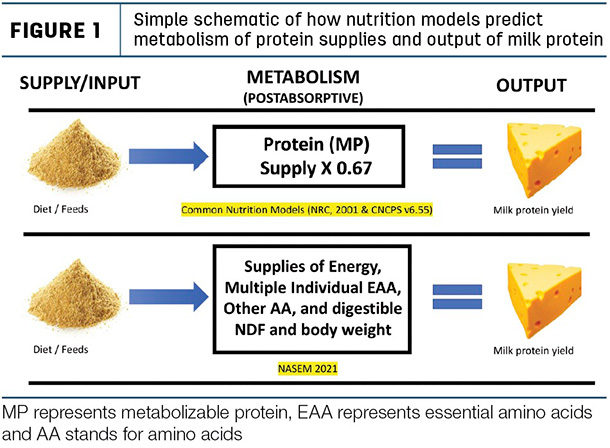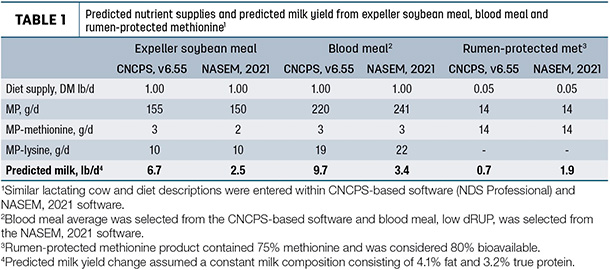Some nutritionists and farms balance diets for amino acids (AAs) to increase milk protein yield, optimize protein efficiency and ensure optimal health of cows.
Another potential reason is for increasing milkfat yield. We know cows respond to individual AAs, and in the past, recommendations have targeted methionine and lysine, as these two AAs were considered the most limiting.
Common nutrition models predict metabolizable protein (MP) allowable milk yield as well methionine and lysine supply targets (National Research Council 2001) or requirements (Cornell Net Carbohydrate and Protein System, CNCPS, version 6.55). It is thought that if dietary methionine and lysine are limiting, which is likely, then milk protein will be constrained depending on the supplies of these AAs (barrel and stave analogy).
MP and AA requirements are derived considering the predefined needs of the animal, i.e., milk protein yield, maintenance, growth and pregnancy. Static efficiencies are defined for the conversion (metabolism) of dietary absorbed MP and AAs into milk protein, growth, etc. As an example, if your cow is producing 80 pounds of milk and 3.2% true protein, then her MP requirements for milk are simply milk protein yield (2.56 pounds per day) divided by a static efficiency of 0.67, which calculates to an MP requirement of 3.82 pounds per day. This is shown in Figure 1.
Improving the AA profile through diet formulation, changing energy supplies or the amount of protein fed does not change this static efficiency – it is fixed at 0.67. The same calculation, though with different individual efficiencies, is done for individual essential amnio acids (EAA) within CNCPS-based models. As an example, your cow’s methionine output in milk protein is 0.08 pounds per day (or 37 grams per day), and if we use the CNCPS static efficiency of 0.67, then the MP-methionine requirement for milk protein is 56 grams per day. In summary, common nutrition models calculate MP and AA requirements using this described approach. However, field adoption or formulation to meet these requirements, particularly for AA, is low with only 20% to 25% U.S. herds estimated to be balancing for AAs. This suggests that perhaps the cows, as well as recent research (not discussed), is telling us that AA nutrition is much more complicated than we previously thought.
Cows possess the metabolic ability to manage diets consisting of varying AA supplies and their corresponding profile. Several researchers have proposed that there is likely not a single optimal EAA profile nor supply for lactating dairy cows. Cows are not like machines with static requirements. For example, your tractor uses a certain amount of fuel (stable efficiency) when in operation, and if it runs out of fuel, then the tractor is inoperable. In contrast, cows can change or flex their metabolism. For example, udder uptake of individual EAAs can vary greatly, and this enables cows to handle various dietary AA profiles. In one study, reducing histidine supply resulted in blood flow rate to the udder increasing by 33% and the machinery that extracts the histidine into the udder increasing activity by forty-threefold.
Cows possess tremendous metabolic flexibility to handle variation in nutrient supply, which is a requirement for life. We have learned there is significant metabolic regulation that enables cows to adapt and coordinate metabolism with nutrient supply and environmental changes. If not, cows would have gone extinct years ago. Regulation of the protein translation machinery with ribosomes, energy status and signals, and transcription of milk protein genes are all factors that can regulate milk protein synthesis and thereby change the utilization efficiency of AAs.
On a broader scale, researchers have identified that protein synthesis is largely regulated by an enzyme complex called mammalian target of rapamycin (mTOR). Several AAs influence mTOR, and in turn stimulate milk protein. In dairy cows, these AAs are thought to be leucine, isoleucine, arginine, methionine and threonine. Recent research has demonstrated positive responses to milk protein independently from leucine and isoleucine despite methionine being limited in dietary supplies. We now know protein metabolism changes with dietary and physiological condition, which changes AA requirements and targeted dietary supply. In summary, calculation of MP and AA requirements is much more complicated than simply using static efficiencies as cows possess significant metabolic flexibility with AA metabolism.
What does this mean for the industry, or how do we apply these concepts? Well, in December 2021, a consensus study report titled “Nutrient Requirements of Dairy Cattle, Eighth Revised Edition” was published by The National Academies of Sciences, Engineering, and Medicine in Washington D.C. This publication, which is referred to as NASEM 2021, represents an updated version of the NRC 2001. The protein chapter provides new guidelines for protein and AA nutrition. A new supply-driven response model is proposed for predicting milk protein and balancing diets for AAs.
Milk protein yield is now predicted from the supplies of five individual EAAs (histidine, isoleucine, leucine, lysine and methionine), the sum of all AAs, digestible energy, digestible neutral detergent fiber (NDF) and bodyweight (Figure 1). This proposed model incorporates the concept that multiple EAAs, as well as energy, can stimulate milk protein, or more broadly, the concepts of mTOR regulation is applied to milk protein production. With this model, there are multiple combinations of AAs and energy supplies that will yield similar yields of milk protein. This is a significant departure from common nutrition models today in that methionine and lysine requirements must be met (barrel and stave analogy) and that a certain ratio of methionine and lysine must be achieved.
In NASEM 2021, it was also recognized that AA efficiency is not static and can vary significantly. The authors suggest calculating the observed AA efficiency for a given diet with observed performance and then comparing this efficiency to target efficiencies to identify which AAs should be added to a diet. In summary, the proposed NASEM 2021 updates encompass the latest research findings related to metabolic flexibility and regulation with protein nutrition. Incorporation of these concepts should improve our prediction accuracy for supplementing AAs and optimizing AA nutrition in the field.
How might this change field formulation and thinking on protein and AA nutrition? First, it may cause the realization that formulation or balancing for AAs is not as simple as we once thought. Conversely, one could suggest that balancing for exact ratios or grams of methionine and lysine was too rigid (constrained), and in fact, this is likely correct. Simply feeding multiple high-protein feedstuffs, more protein and more energy should help optimize milk protein yield, and the new approach likely encompasses this strategy. Secondly, we should consider that more AAs than simply methionine and lysine are important. This means that rumen-protected AAs should not be compared to feed protein on a single AA basis. Thirdly, you may want to consider evaluating your current protein and AA supplementation strategies using the new NASEM software. For example, consider evaluating model predictions from changing supplies of rumen-protected AAs or high rumen-undegradable protein (RUP) feedstuffs.
Click here or on the image above to view it at full size in a new window.
In Table 1, we have compared the predicted milk response (assuming a constant 3.2% true protein) from feeding 1 pound of expeller soybean meal and blood meal and 0.05 pounds of rumen-protected methionine using CNCPS version 6.55 and NASEM 2021 software. For expeller soybean meal and blood meal, the predicted milk response was 63%-65% lower with the NASEM model compared to the CNCPS prediction. For rumen-protected methionine, the opposite occurred, in that the NASEM predicted milk (or milk protein) response was 2.7 times greater than the CNCPS prediction. From a personal perspective, the NASEM predictions herein for these ingredients appear much more robust and congruent with research studies and field observations. Hence, there might be value in you utilizing NASEM for evaluating post-absorptive protein and AA metabolism to better assess your current formulation strategies.
In summary, AA nutrition is much more complex than simply methionine and lysine. We are learning that there are many factors independent of methionine and lysine supplies that regulate milk protein production. Common field nutrition models generally do not encompass this complexity. The new publication by the NASEM committee has attempted to address this complexity, and they have released a new approach for balancing diets for AAs. We should recognize that no model is perfect, but some are useful. The new NASEM approach and model are likely more useful for describing the metabolism and biology of the cow than common nutrition models. This will potentially be quite useful for farmers and nutritionists alike, as it may provide a more robust ability to optimize income over feed costs and milk protein yields when formulating diets for AA supply. ![]()
Peter Yoder is a technical services manager for Perdue AgriBusiness. Email Peter Yoder.







